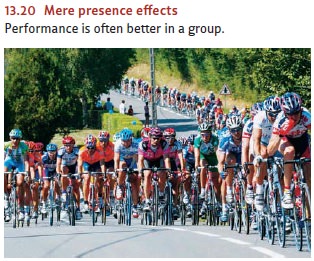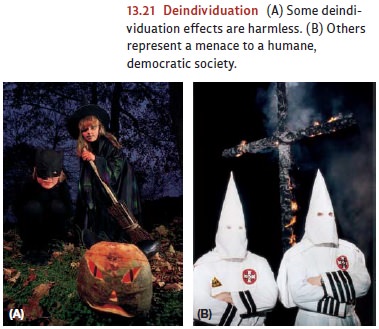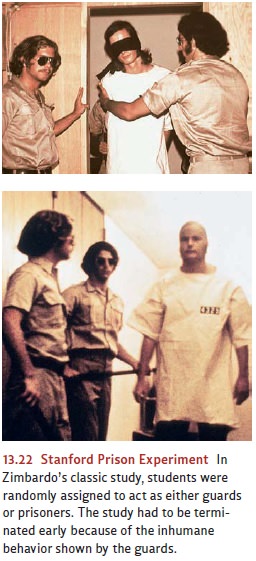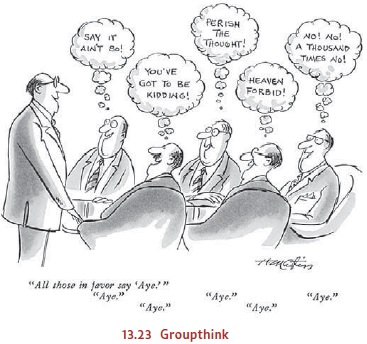Chapter: Psychology: Social Psychology
Social Influence: Group Dynamics
Group Dynamics
So
far, we have described social influence as though it were a “one-way street.”
The group presses you toward conformity. A salesperson leads you toward a
concession. But, of course, social interactions often involve mutual
influence—with each person in the group having an impact on every other person
in the group. The study of this sort of interaction is the study of group dynamics.
MERE PRESENCE EFFECTS
More
than a century ago, Triplett noticed that cyclists performed better when they
competed against others than when they competed against the clock (Triplett,
1898; Figure 13.20). This observation inspired him to conduct one of social psychology’s
first experiments, in which he told children to turn a fishing reel as quickly
as they could, either alone or with another child. Triplett found that children
turned the reel more quickly when they were with others than when they were
alone.
This
finding was subsequently replicated many times, and initial results suggested
that this mere presence effect was
uniformly beneficial. For example, when working alongside others who are
engaged in the same task, people learn simple mazes more

quickly
and perform more multiplication problems in the same period of time—
illustrations of a pattern known as social
facilitation (F. H. Allport, 1920). Other stud-ies, however, show that the
presence of others can sometimes hinder rather than help—an effect called social inhibition. While college
students solve simple mazes more quickly when working with others, they are
considerably slower at solving more complex mazes when others are around (Hunt
& Hillery, 1973; Zajonc, 1965, 1980). How can we reconcile such divergent
results?
Zajonc
(1965) argued that the presence of other people increases our level of bod-ily
arousal, which strengthens the tendency to perform highly dominant responses—
the ones that seem to come automatically. When the dominant response is also
the correct one, as in performing simple motor skills or learning simple mazes,
social presence should help. But when the task gets harder, as in the case of
complex mazes, then the dominant response is often incorrect. As a result,
performance gets worse when others watch, for in that case the dominant
response (enhanced by increased arousal) inhibits the less dominant but correct
reaction.
Evidence
supporting this view comes from a wide array of studies. In one study,
researchers observed pool players in a college union building. When good
players competed in front of an audience of four others, their accuracy rose
from 71 to 80%. But when poor players were observed, their accuracy dropped from
35 to 25% (Michaels, Bloomel, Brocato, Linkous, & Rowe, 1982). Similar
effects can be observed even in organisms very different from humans. In one
study, cockroaches learned to escape from a bright light by running down a
simple alley or by learning a maze. Some performed alone; others ran in pairs.
When in the alley, the cockroaches performed better in pairs than alone—for
this simple task, the dominant response was appro-priate. In the maze, however,
they performed better alone; for this more complex task, the dominant response
was incorrect and inappropriate (Zajonc, Heingartner, & Herman, 1969).
SOCIAL LOAFING
The
studies just described are concerned with people working independently of each
other or people working in the presence of an audience. But what about people
work-ing together—such as a committee working on an administrative project, or
a group of students working on a class project? In cases like these, everyone
is a performer and an audience member, because every member of the group is contributing
to the overall product. Likewise, everyone is able to see and perhaps evaluate
others’ contributions. How do group members influence each other in this
setting?
In
this situation, we are likely to observe a phenomenon known as social loafing (Latané, 1981), a
pattern in which individuals working together in a group generate less total
effort than they would if each worked alone. In one study, individual men were
asked to pull on a rope; the average force for these pulls was 139 pounds. When
groups of eight pulled together, the average was 546 pounds—only about 68
pounds per per-son. In another study, students were asked to clap and cheer as
loudly as they could, sometimes alone, sometimes in groups of two, four, or
six. Here, too, the results showed social loafing. Each person cheered and
clapped less vigorously the greater the number of others she was with (Latané,
Williams, & Harkins, 1979). This general finding that individuals work less
hard in groups has now been replicated many times in the United States, India,
and China (Karau & Williams, 1993).
Why do individuals work less hard in groups? One reason is that
they may feel less accountable and therefore are less motivated to try as hard
as they can. Another reason is that they may think that their contribution is
not crucial to group success (Harkins Szymanski, 1989). There is an old adage:
“Many hands make light work.” The trou-ble is that they do not always make it
as light as they could.
DEINDIVIDUATION
Apparently,
then, the presence of others can influence us in multiple ways—in some
circumstances facilitating our behavior, and in other circumstances inhibiting
us. But the presence of others can also dramatically change how we act. In a
riot or lynch mob, for example, people express aggression with a viciousness
that would be inconceivable if they acted in isolation. A crowd that gathers to
watch a disturbed person on a ledge atop a tall building often taunts the
would-be suicide, urging him to jump. What does being in a crowd do to people
to make them act so differently from their everyday selves?
One
perspective on these questions describes crowd behavior as a kind of mass
mad-ness. This view was first offered by Le Bon (1841–1931), a French social
psychologist who contended that people in crowds become wild, stupid, and
irrational and give vent to primitive impulses. He believed their emotion
spreads by a sort of contagion, rising to an ever-higher pitch as more and more
crowd members become affected. Thus, fear becomes terror, hostility turns into
murderous rage, and each crowd member becomes a barbarian—“a grain of sand
among other grains of sand, which the wind stirs up at will” (Le Bon, 1895).
Many
modern psychologists believe that although Le Bon may have overstated his case,
his claims contain an important truth. To them, the key to crowd behavior is dein-dividuation, a state in which an
individual in a group loses awareness of herself as aseparate individual
(Figure 13.21). This state is more likely to occur when there is a high level
of arousal and anonymity—just as would be the case in a large and angry crowd
or a large and fearful gathering. Deindividuation tends to release impulsive
actions that are normally under restraint, and what the impulses are depends on
the group and the situation. In a carnival, the (masked) revelers may join in
wild orgies; in a lynch mob, the group members may torture or kill (Diener,
1979; Festinger, Pepitone, & Newcomb, 1952; Zimbardo, 1969).

To
study deindividuation, one investigation had college students wear identical
robes and hoods that made it impossible to identify them. Once in these hoods—
which, not coincidentally, looked just like Ku Klux Klan robes—the students
were asked to deliver an electric shock to another person; they delivered twice
as much shock as those not wearing the robes (Zimbardo, 1970). In the robes, it
seemed, the students felt free to “play the part”—and in this case the result
was ugly. Other stud-ies, though, reveal the good that can be produced by
deindividua-
tion.
In a different experiment, students were asked to wear nurses’ uniforms rather
than KKK costumes; dressed in this way, students delivered less shock than a
group without costumes (R . D. Johnson & Downing, 1979). Thus,
deindividuation by itself is not bad—it simply makes it easy for us to give in
to the impulses cued by the sit-uation, and the nature of those impulses
depends on the circum-stances.
Notice
also that deindividuation can happen in several different ways. Being in a
large crowd produces deindividuation; this is part of why mobs act as they do.
Wearing a mask can also produce dein-dividuation, largely because of the
anonymity it provides. But dein-dividuation can also result merely from
someone’s wearing a uniform and having an assigned role—in essence, he
“becomes” the

role.
This third factor was plainly revealed in a classic study known as the StanfordPrison Experiment, in which
Philip Zimbardo transformed the basement of StanfordUniversity’s psychology
department into a mock prison and randomly assigned male undergraduate
participants to the role of either guards or prisoners (Figure 13.22; Haney,
Banks, & Zimbardo, 1973; Zimbardo, 1973; see also Haney & Zimbardo,
1998). Guards and prisoners wore uniforms appropriate to their roles, and
prisoners were called by assigned numbers instead of their names. The
experimenter gave the partic-ipants few instructions, and placed few
constraints on their behavior. What rapidly evolved was a set of behaviors
remarkably similar to those sometimes observed in actual prisons—with cruelty,
inhumane treatment, and massive disrespect evident in all the participants. The
behaviors observed were sufficiently awful that Zimbardo ended his study after
only 6 days, before things got really out of hand, rather than let-ting it run
for 2 weeks, as was originally planned.
Sadly,
the powerful effects of deindividuation and stepping into a role extend well
beyond the confines of the laboratory setting. As we saw, one now-infamous
real-world example is the abusive behavior exhibited by military personnel at
Abu Ghraib prison. In the face of worldwide condemnation, Americans of all
stripes struggled to understand how their own countrymen and countrywomen could
behave in such an unconscionable fashion. Mindful of the lessons of the
Stanford Prison Experiment, though, Zimbardo and other social psychologists
have argued that powerful social forces were at work here that included—among
others— the power of deindividuation through reducing people to their roles
(Zimbardo, 2007). As a result, the situation itself may have done far more to
create these abuses than the personal qualities of any of the soldiers
involved.
GROUP POLARIZATION
Being
in a group doesn’t just influence our behavior; it also influences our
thoughts— and often for the worse. For example, consider the phenomenon of group polarization, a tendency for
group decisions to be more extreme than the decisions that would have been made
by any of the members on their own. This pattern arises in many different group
contexts, such as when juries decide how much money to award a plaintiff at the
end of a lawsuit.
Often
the polarization takes the form of a so-called risky shift, in which groups appear more willing to take risks, or
more willing to take an extreme stance, than the group members would be
individually (Bennett, Lindskold, & Bennett, 1973; C. P. Morgan & Aram,
1975; Schroeder, 1973). However, group polarization can also take the opposite
form. If the group members are slightly cautious to begin with or slightly
con-servative in their choices, then these tendencies are magnified, and the
group’s decision will end up appreciably more cautious than the decisions that
would have been made by the individuals alone (Levine & Moreland, 1998;
Moscovici & Zavalloni, 1969).
What
produces group polarization? One factor is the simple point that, during a
dis-cussion, individuals often state, restate, and restate again what their
views are, which helps to strengthen their commitment to these views (Brauer,
Judd, & Gliner, 1995). Another factor involves the sort of confirmation
bias that we discussed— the fact that people tend to pay more attention to, and
more readily accept, information that confirms their views, in comparison to
their (relatively hostile) scrutiny of information that challenges their views.
How does this shape a group discussion? In the discussion, people are likely to
hear sentiments on both sides of an issue. Owing to confirmation bias, the
arguments that support their view are likely to seem clear, persuasive, and
well informed. Opposing arguments, however, will seem weak and ambiguous. This
allows people to conclude that the arguments favoring their view are strong,
while the counterarguments are weak, which simply strengthens their commit-ment
to their own prior opinion (for the classic example of this pattern, see C. G.
Lord, Ross, & Lepper, 1979; also Kovera, 2002).
Another
factor leading to group polarization hinges on two topics we have already
mentioned. On the one hand, people generally try to conform with the other
mem-bers of the group, both in their behavior and in the attitudes they
express. But, in addition, people in individualistic cultures want to stand out
from the crowd and be judged “better than average.” How can they achieve both
of these goals—conform-ing and excelling? They can take a position at the
group’s “leading edge”—similar enough to the group’s position so that they have
honored the demands of conform-ity, but “out in front” of the group in a way
that makes them seem distinctive. Of course, the same logic applies to everyone
in the group, so everyone will seek to take positions and express sentiments at
the group’s leading edge. As a result, this edge will become the majority view!
In this way, right at the start the group’s sentiments will be sharpened and
made a step or two more extreme—exactly the pattern of group polarization.
GROUP THINK
Group
decision making also reveals a pattern dubbed groupthink (Janis, 1982). This pattern is particularly likely when
the group is highly cohesive—such as a group of friends or people who have
worked together for many years—and when the group is facing some external
threat and is closed to outside information or opinions. In this setting, there
is a strong tendency for group members to do what they can to promote the sense
of group cohesion. As a result, they downplay doubts or disagreements,
celebrate the “moral” or “superior” status of the group’s arguments, stereotype
enemies (“our opponents are stupid” or “evil”), markedly overestimate the
likelihood of success, and dis-count or ignore risks or challenges to the group
(Figure 13.23).

Arguably,
groupthink caused a number of disastrous decisions, including the U.S.
government’s decision to invade Cuba in the early 1960s (Janis, 1971) and the National
Aeronautics and Space Administration’s decision to launch the Challenger on a cold day in 1986 despite
the knowledge that one part of the space shuttle did not perform well at very
cold temperatures (Moorhead, Ference, & Neck, 1991). Social psychologists
are still working to understand exactly when the groupthink pattern emerges and
what steps can be taken to limit the negative effects of groupthink on decision
making (Kruglanski, Pierro, Mannetti, & De Grada, 2006; Packer, 2009).
Related Topics